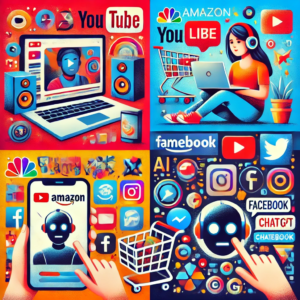Popular Online Services and Tools: YouTube, Amazon, Facebook, and ChatGPT.”
Section 1: Introduction
1.Overview of Online Services and Tools
•Introduction to the global impact of online platforms, with YouTube, Amazon, Facebook, and ChatGPT as examples of the most widely used services across various sectors.
2.Why These Platforms are Popular
•A discussion on why these specific platforms stand out, covering factors like accessibility, user-friendliness, and innovation in user engagement.
Section 2: YouTube – The World’s Video Platform
1.History and Growth of YouTube
•A brief history of YouTube, from its inception in 2005 to becoming the world’s largest video-sharing platform.
2.Features and Tools
•Detailed analysis of features like channels, playlists, live streaming, and monetization options, as well as YouTube’s premium services.
3.Impact on Content Creation and Entertainment
•The rise of the YouTube creator economy, where individuals and businesses make income through ads, sponsorships, and merchandise.
4.Educational Influence
•How YouTube has transformed access to educational content through tutorials, lectures, and DIY videos.
5.Challenges and Controversies
•Key issues faced by YouTube, such as copyright concerns, misinformation, and content moderation challenges.
Section 3: Amazon – Revolutionizing E-commerce
1.Amazon’s Journey
•A look at Amazon’s evolution from an online bookstore to a multi-industry giant offering products and services worldwide.
2.Key Features of Amazon
•Analysis of services such as Amazon Prime, Amazon Web Services (AWS), Kindle, and Alexa, exploring how each contributes to Amazon’s ecosystem.
3.Transformation of the E-commerce Industry
•How Amazon has redefined consumer expectations with fast delivery, vast inventory, and personalized shopping.
4.Amazon’s Role in Small Business and Employment
•The role of Amazon Marketplace

1. YouTube: The Go-To Platform for Video Content
Overview: Launched in 2005, YouTube is the world’s largest video-sharing platform, offering a space for users to create, watch, and share videos on virtually any topic. Its influence spans entertainment, education, marketing, and social activism.
Core Features:
•Channels and Subscriptions: Users can follow content creators, who build communities around specific topics like gaming, beauty, science, and more.
•Monetization: Through ads, sponsorships, and membership features, YouTube has enabled millions to turn content creation into a profession.
•Live Streaming: Offers real-time interaction, enhancing engagement and audience reach.
Impact:
YouTube’s role in democratizing information is substantial. Tutorials, educational channels, and vlogs bring knowledge and ideas to a global audience. It’s a hub for influencers and an essential tool for digital marketing, as brands reach audiences through ads and partnerships.
2. Amazon: Transforming Shopping and Tech Services
Overview: Amazon, founded in 1994, started as an online bookstore and has grown into one of the largest online marketplaces, as well as a leader in cloud computing (Amazon Web Services).
Key Features:
•E-commerce: Amazon offers a vast range of products, competitive pricing, and fast delivery options, including same-day delivery.
•Amazon Prime: Members access perks like free shipping, streaming on Prime Video, and discounts.
•AWS (Amazon Web Services): Powers countless websites and applications, providing cloud storage, computing power, and more.
Impact:
Amazon has revolutionized online shopping, setting new standards for convenience and customer experience. AWS’s success has also made Amazon a core provider of cloud services, supporting businesses of all sizes with scalable tech solutions.
3. Facebook: Building Social Connections
Overview: Facebook, founded in 2004, remains one of the leading social media networks. With over 2 billion users, it has expanded beyond social networking to encompass messaging, marketplaces, and virtual reality.
Core Features:
•News Feed and Stories: Users share updates, photos, and videos, while algorithms suggest content based on interests.
•Marketplace and Facebook Business: Businesses use Facebook for ads, storefronts, and customer engagement.
•Messenger and Groups: Foster connections and community, offering users a place to meet people with shared interests.
Impact:
Facebook has had a profound impact on global communication, social trends, and digital marketing. Despite controversies around privacy and content moderation, it remains a primary tool for connecting people worldwide.
4. ChatGPT: The Rise of AI Assistants
Overview: ChatGPT, launched by OpenAI, represents the potential of AI-driven conversational tools. Built using advanced natural language processing, it assists with tasks ranging from answering questions to drafting emails.
Core Features:
•Conversational Assistance: ChatGPT can answer complex queries, generate text, and even offer language translations.
•Productivity and Learning: Students, professionals, and creatives use it for brainstorming, summarizing, and learning new topics.
•Continuous Learning: As it interacts with users, ChatGPT improves its accuracy and language fluency, adapting to a broad array of topics.
Impact:
ChatGPT showcases AI’s potential to boost productivity and transform industries like customer support, education, and creative writing. It demonstrates how AI can be a practical tool in daily life, though ethical concerns about AI’s future and limitations persist.
Broader Impact of These Tools on Society
These platforms have collectively changed the digital landscape by making information, social interaction, and shopping more accessible. They play significant roles in the economy, from content creation jobs on YouTube to small businesses leveraging Amazon and Facebook for outreach. AI tools like ChatGPT continue to shape future expectations around automation and personalized assistance.
The combination of these tools illustrates how technology has reshaped how we learn, connect, and even think. Despite challenges like privacy, misinformation, and ethical considerations, each of these platforms has left an indelible mark on the digital world.
